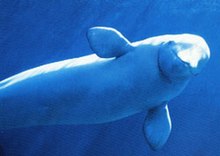Monodontidae
| Monodontidae Temporal range:
| |
|---|---|

| |
| Beluga whale | |
| Scientific classification | |
| Domain: | Eukaryota |
| Kingdom: | Animalia |
| Phylum: | Chordata |
| Class: | Mammalia |
| Order: | Artiodactyla |
| Infraorder: | Cetacea |
| Superfamily: | Delphinoidea |
| Family: | Monodontidae J. E. Gray, 1821 |
| Type genus | |
| Monodon C. Linnaeus, 1758
| |
| Extant genera | |
The
Monodontids have a wide-ranging carnivorous diet, feeding on fish, molluscs, and small crustaceans. They have reduced teeth, with the beluga having numerous simple teeth, and the narwhal having only two teeth, one of which forms the tusks in males. Gestation lasts 14–15 months in both species, and almost always results in a single calf. The young are not weaned for a full two years, and do not reach sexual maturity until they are five to eight years of age. Family groups travel as part of herds, or 'pods', which may contain several hundred individuals.[2]
Taxonomy

The monodontids, oceanic dolphins (Delphinidae) and porpoises (Phocoenidae) together comprise the Delphinoidea superfamily. Genetic evidence suggests the porpoises are more closely related to the white whales, and these two families constitute a separate clade which diverged from the Delphinidae within the past 11 million years.[3][4]
- Suborder Odontoceti
- Superfamily Delphinoidea
- Family Monodontidae
- Genus †Haborodelphis
- Haborodelphis japonicus
- Genus † Denebola
- Denebola brachycephala
- Genus †Haborodelphis
- Subfamily Delphinapterinae
- Genus Delphinapterus
- Delphinapterus leucas, beluga
- Genus †Casatia
- Casatia thermophila
- Genus
- Subfamily Monodontinae
- Family Monodontidae
- Superfamily Delphinoidea
References
External links
 Media related to Monodontidae at Wikimedia Commons
Media related to Monodontidae at Wikimedia Commons Data related to Monodontidae at Wikispecies
Data related to Monodontidae at Wikispecies
